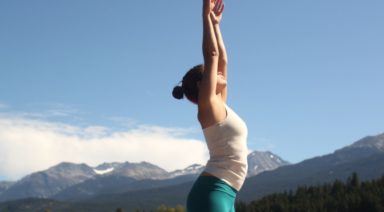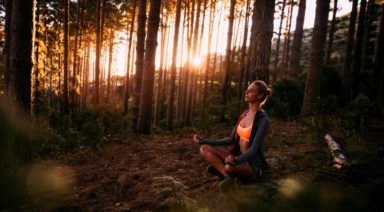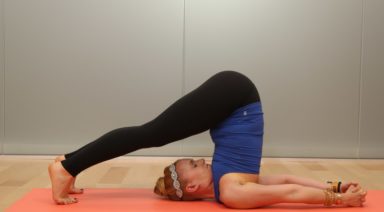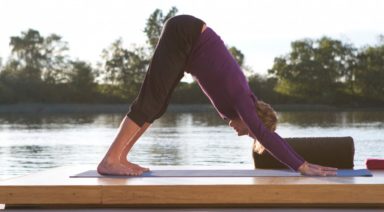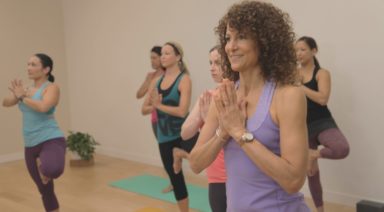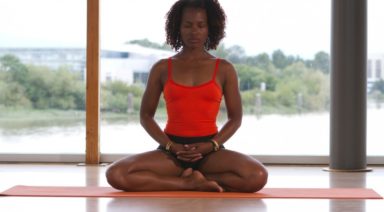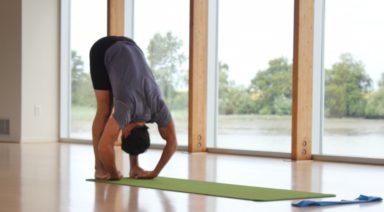Yin Yoga Benefits and History

Maybe you’ve heard of yin yoga but don’t really know what it is. Maybe you’ve tried it but lack some understanding of its origin or purpose. Or perhaps this is the first you’re hearing of it.
This exploration of the benefits and history of yin yoga will provide you some understanding of where yin came from and how it benefits people. If you find it compelling, get on your mat, keep learning more, and let us know how your journey unfolds.
To prepare for this article, I interviewed several Boston-based yin yoga teachers and regular practitioners. This is their scoop, filtered through some of my own experiences on what the benefits of this slow, meditative practice are.
What are the Benefits of Yin Yoga?
Seeing Within
When practicing this turtle-paced yoga style, unlike other varieties that are fast-moving and fancy looking, there is no wow-factor for spectators. Because yin yoga stretches connective tissue, especially at the joints, difficult inversions and impressive poses wouldn’t be safe considering how long they are to be held (anywhere from a couple of minutes up to around 20 minutes). To experience the wonders of yin, practitioners simply hold well-aligned, basic poses.
Doing poses in stillness promotes the cultivation of the inner life.
As yin yoga enthusiast Kourtney Hartmoyer has so eloquently put it, “the shapes are simple, perhaps even boring. To the outside world, it doesn’t look too interesting. However dull from an outside view, what I have found is that the quiet stillness of yin allows me to better observe the inner self a bit more clearly. It magnifies everything. That is where I find the magic.”
I have felt the magic, too. Yin yoga helps me to see myself on a deeper level through the cultivation of stillness. When I practice it’s not always easy or even possible to become physically still. Yet when I am able to “drop-in” and become motionless, the depth of awareness is simultaneously awe-inspiring and intrinsically peaceful. I can watch the inner play of my mind and subtle body as an observer. I can see within.
If you are planning to start a yin practice, it’s okay not to be absolutely still. It’s okay to struggle. The struggle contains information you can observe with kindness and curiosity. And when it finally subsides and you can be still, you can move deeper into yourself and into greater states of euphoric relaxation.
Moving Into Deeper States of Relaxation
Joanna Barrett told me that her daily yin practice helps her “to sit with sensation, moving toward or into deeper states of relaxation.” Moving quickly cannot promote deep trance-like states in the manner utter stillness can. If you’re curious, swap out the vinyasa flow for a yin vibe to appreciate what Joanna is talking about.
The depths of relaxation may require some preparation and commitment of time. It wouldn’t make sense for you to rush into a meditative state.
You’ll need time to allow your body to slowly drop into the depths of each pose. Completely support yourself with props, breathing deeply with lungs that move air like the bellows that feed fire.
Sure enough, the depth of sensation will tempt you to get out of the pose. I urge you to remain still while breathing deeper to experience the peace and meditation of true surrender. Can you stay just a little longer and relax just a little more? That might require a great deal of patience.
Building Patience and Receptivity
When I interviewed Yeradmi Gomes, Boston-based yin yoga instructor and jack of many trades, she said that in yin, “there isn’t much physical movement, which requires lots of patience and receptivity.” Contemporary people don’t necessarily have either in abundance. Riding the New York subways I have seen the lack of patience: People are quick to rush by; they often won’t stop to enjoy beautiful music playing; they aren’t open to seeing or conversing with a person in need of kindness; they outright ignore them and are usually closed to conversation with others. I admit to living this way in public spaces.
I have come to notice that this behavior bleeds into other areas of my life. Sometimes when loved ones are talking to me, I can feel myself wishing they’d rush to the finish. I am not always open to receive compliments or to stop and smell the proverbial roses.
While I feel at my core that I am patient and receptive, there are countless examples of times I was neither. And while all readers may not ride the subway or live in a busy city, there are surely ways we collectively live that lack both qualities. What might you be missing when you lack patience and receptivity? When you can’t sit with things as they are, what experiences might you be blocking? Can you imagine how being still for extended periods might build your patience and help you to be open to receive what life is offering you? How might establishing a Yin practice contribute to your continued development of patience and receptivity?
Feeling Release and Relief
Yeradmi went on to talk about the relief she feels from yin. “My body feels more open, flexible and at ease. I sleep better and I have greater awareness of how I move in space and the way my body feels. My favorite part of the practice is getting out of a pose and feeling the blood flow, it creates an enjoyable sense of release and relief.”
Most of America needs better and more sleep. This practice can provide relief from wakefulness and restlessness at night. Yin can be your new alternative to late-night screen-time, Research has proven that screens at night give the brain a message to be wakeful, which can disrupt sleep. You could instead drift off to dreamland after your yin practice.
The Chicken Soup of Yoga
The benefits of yin are numerous. Perhaps my favorite from the interviews I conducted came from Kourtney Hartmoyer. She wrote, “yin yoga is a deeply restorative, nurturing and healing practice. I think of it as the chicken soup of yoga.” But what makes it so nurturing?
Stretching the Joints?
One of the most renowned yin yogis in the world is Paul Grilley. In yin, we don’t stretch the joints, but the connective tissue that is centralized at the joints. Gilley states, “In general, a yin approach works to promote flexibility in areas often perceived as non-malleable, especially the hips, pelvis and lower spine… connective tissue responds best to a slow, steady load. If you gently stretch connective tissue by holding a yin pose for a long time, the body will respond by making them a little longer and stronger—which is exactly what you want.” In order to maintain a healthy range of motion, to have good mobility and comfort in the body, yin is an excellent practice. It is nurturing to the body physically and considering all the aforementioned benefits, mentally and emotionally, too.
What is Hatha Yoga?

If you’ve been practicing yoga for any length of time, you’ve probably heard of Patanjali’s Yoga Sutras. The text, which was written around the second century CE, consists of a compilation of yoga practices derived from older Hindu and Buddhist yogic traditions. Consisting of four chapters of 196 aphorisms, the text enumerates the eight-limbed ashtanga approach to yoga.
Patanjali’s ashtanga yoga system, (not to be confused with the contemporary ashtanga system of Pattabhi Jois) details a full overview of yogic practices. It includes social and ethical precepts, (yama and niyama) guidelines for physical practices, (asana and pranayama) and a full overview of mental states that arise during meditative concentration (pratyahara, dharana, dhyana and Samadhi).
Yoga as a Cohesive System
The Yoga Sutras are important because it was the first time that the central elements of Yogic theory and practice had been collected and documented in one place. Before Patanjali, most textual mentions of yoga were scattered among a large number of manuscripts from different traditions. During that time, anyone wishing to engage in a full comprehensive overview of yogic practices would be required to learn a number of different languages in order to study a diverse number of traditional texts drawn from Hindu, Buddhist and Jain sources.
Once Patanjali had codified this systematic approach to yoga practices, the practice itself became more accessible. As a result yoga continued to mature as a discipline over the coming centuries. With time, other full-fledged yogic systems came into being as well. One of the most well-known systems – Hatha Yoga (the forceful yoga) began to develop sometime between the 9th and 12th century CE.
The Godfather of Hatha Yoga: Gorakshanath
Hindu traditions accredit the creation of Hatha Yoga to Gorakshanath and his teacher Matsyendranath. Both of these men were Bengali in origin. Goraksha Nath in particular was recognized as a highly accomplished practitioner, and was considered by many to be a miracle worker, saint, and revered teacher during his time. During his time, he founded the Nath movement in Northern India.
Known to have drawn inspiration from both Buddhist and Hindu sources, Gorakshanath is accredited with the creation of a number of important oral teachings and Sanskrit texts. These texts include The Siddha Siddhanta Paddhati, and a separate important treaty on Hatha Yoga, titled the Goraksa Sataka.
With time, other well-known Hatha Yoga practitioners continued to contribute to the Hatha Yoga canon and additional texts were written to support the practice as well. The Hatha Yoga Pradipika (15th century) and Gheranda Samhita (17th century) – both anthologies of various texts – are important treatises on the practice of Hatha Yoga.
Divine Purification through Physical Means
Though many of the tenants and practices of Hatha Yoga parallel the eight limbed system found in the Yoga Sutras of Patanjali, there are substantial differences as well. The Hatha yoga of Goraksha Nath established a close connection between Indian medicine, and the principles of yoga and alchemy. As such, traditional Hatha Yoga teachings tended to emphasize physical practices more extensively than did the Yoga Sutras.
Like the Yoga Sutras, the ultimate aim of the Hatha Yogi was enlightenment. However, the practices differed substantially in their respective methodologies. Followers of the Yoga Sutras believed that the restraint of consciousness was the way to achieve liberation. In contrast, Hatha Yogis believed that liberation could be more quickly achieved through a sophisticated set of transformational practices designed to purify the physical body and mind through energy practices.
To begin these practices, Hatha Yogis were required to perform extensive purification rituals before beginning asana and pranayama practices under the careful guidance of a guru.
As part of their training, students of Hatha Yoga were also required to learn a comprehensive energy map of the body. This map contained among other things an overview of channels (nadis), chakras (energy wheels), winds (vayus) and “drops” (bindu) consisting of male (lunar) and female (solar) energies.
Once the Hatha Yogi had completed this preliminary work, they engaged in a persistent, daily effort to force the body’s energy winds (vayus) to enter the central energy channel (Susumna). The energy from these winds was then used to unite contrasting polarities of masculine and feminine energy.
The term Hatha makes reference to this practice and is often explained as the conjunction of the feminine solar force – represented by the syllable HA – and the masculine lunar force symbolized by the syllable THA.
Typically, this process of conjoining energies was accomplished through a combination of physical asanas, breathing exercises and meditative contemplations based on deities.
The overall aim of this practice of conjoining energies was to activate the vital life force (Kundulini) that is said to lie dormant in the central channel. In the Buddhist tradition of Hatha Yoga (Naljor), practitioners activate a great heat at the navel chakra. This heat was then used to induce four states of bliss that could provide deeper insights into the ultimate nature of reality.
Through this process the Hatha Yoga gradually strove to transform the physical body into a subtle, divine body. This body, (sometimes referred to as the adamantine body or vajra body) was said to be purer than the sky impervious to disease, void of any defects, eternally youthful, and the bearer of paranormal, magical powers.
Techniques and Benefits of Hatha Yoga
While asana and pranayama played an important role in Hatha Yoga practices, other disciplines were used for physical purification as well. The Gheranda Samhita, a seventeenth century manual of Hatha Yoga, lists six separate purification practices that were used to achieve the adamantine body by tempering the physical body through the fire of yoga.”
These practices include:
Neti
Neti practices primarily consist of nasal cleansing exercises with oil, water or a thin string. Benefits of this practice include lubrication of the mucous membrane, less susceptibility to colds, an improvement in allergy related symptoms and a clearing of the nasal passages.
Dhauti
These cleansing techniques include a diverse set of practices to cleanse the stomach with a combination of saline solutions, air, or a long swath of cotton cloth. Benefits of these practices are said to include an alleviation of constipation, indigestion, hypo and hyper acidity.
Nauli
This forceful exercise consists of a strong rotation of the abdominal muscles and is said to stimulate digestion, tone the abdominal organs and massage the internal organs.
Vasti
Vasti practices utilize various types of enema to encourage the expulsion of accumulated toxins in the colon. Benefits of this Hatha Yoga practice can include regular bowel movements and increased digestive health.
Kapalabhati
Also called the skull shining breath, Kapalabhati is an active breathing practice that can be used to purify energy channels, calm the mind and tone the abdominal muscles.
Trataka
In Hatha Yoga, trataka exercises are used to purify the eyes. To do this exercise, the practitioner fixes his or her eyes on a single point for extended periods of time. Regular practice of trataka can improve the ability to concentrate and deepen meditative practices.
Adaptation to the Modern World
Traditional Hindu and Buddhist Hatha Yoga is still practiced to this day in unaltered form in Tibetan Buddhist monasteries and Hindu ashrams around the world. However, Hatha Yoga as a whole has continued to evolve and adapt to fit the needs of the modern world.
Since the turn of the 20th century, the Hatha Yoga postural corpus has continued to grow. During the Hatha Yoga Renaissance, there were less than 100 recognized yoga postures. Today, this number has grown to thousands of potential variations which are regularly practiced in yoga studios throughout the world.
Three Indian teachers in the early part of the twentieth century contributed to the ever-changing landscape of Hatha Yoga practice through independent study and practice.
By expanding the Hatha Yoga repertoire and presenting it not only to the uninitiated layman, but to women as well, these teachers popularized the practice and made it available to millions around the world.
Swami Kuvalayananda focused primarily on the health benefits of practicing yoga; Swami Sivananda in Rishikesh fused together three different types of practice (Karma, Jnana and Bhakti) to create a modern approach to yoga, and T. Krishnamacharya (the teacher of B.K.S. Iyengar and Pattabhi Jois) of Mysore concentrated on developing a larger and more varied postural repository by integrating an eclectic array of exercises from other movement disciplines into the practice.




